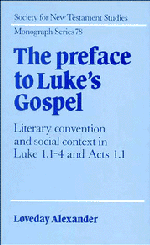Book contents
- Frontmatter
- Contents
- Acknowledgements
- Abbreviations
- 1 The Lucan preface: questions and assumptions
- 2 On the beginnings of books
- 3 Historical prefaces
- 4 Scientific prefaces: origins and development
- 5 Scientific prefaces: structure, content and style
- 6 Luke's preface
- 7 Prefaces in hellenistic Jewish literature
- 8 The social matrix of Luke's preface
- 9 The appropriate form of words for the occasion
- Appendix A Structural analysis of Luke 1.1–4 and selected scientific prefaces
- Appendix B Bibliographical notes on scientific prefaces
- Select bibliography
- Index of scientific authors
- Index of ancient authors and names
- Index of modern authors
- Index of subjects
7 - Prefaces in hellenistic Jewish literature
Published online by Cambridge University Press: 15 October 2009
- Frontmatter
- Contents
- Acknowledgements
- Abbreviations
- 1 The Lucan preface: questions and assumptions
- 2 On the beginnings of books
- 3 Historical prefaces
- 4 Scientific prefaces: origins and development
- 5 Scientific prefaces: structure, content and style
- 6 Luke's preface
- 7 Prefaces in hellenistic Jewish literature
- 8 The social matrix of Luke's preface
- 9 The appropriate form of words for the occasion
- Appendix A Structural analysis of Luke 1.1–4 and selected scientific prefaces
- Appendix B Bibliographical notes on scientific prefaces
- Select bibliography
- Index of scientific authors
- Index of ancient authors and names
- Index of modern authors
- Index of subjects
Summary
A stylistic hybrid?
We are now in a position to see in what respects Luke's preface approaches those of the scientific writers. In structure, it is remarkably close; its linguistic usages are of a broadly similar type, and many of its concepts and key words can be elucidated from the conventions of scientific prefaces. Moreover, there are points where it is clear that Luke fits specifically into the practice of the later scientific writers rather than the earlier, that is into the conventional pattern of the Greco-Roman period rather than that of the hellenistic. These points include the brevity and compression of Luke's preface; the placing of the vocative; the lack of specific information about the subject of the book; the use of the opening clause to refer to predecessors rather than to the disposition of the dedicatee; and the use of autoptai. Within that later group, Luke's preface may be distinguished from the more extravagant examples of the genre (Erotian, Thessalus, Artemidorus): his language is simple and modest, and there are no excessive claims. Probably the closest parallel overall is with the prefaces of Hero of Alexandria, which date from around AD 70 – which is, of course, well within the range of dates probable for Luke's literary activity.
There are, however, as we have seen, points in the Lucan preface which do not fit into the pattern of scientific preface-convention.
- Type
- Chapter
- Information
- The Preface to Luke's Gospel , pp. 147 - 167Publisher: Cambridge University PressPrint publication year: 1993

